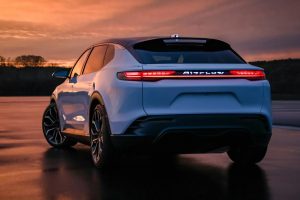This 33-year-old made the world's fastest electric car. Now he's running Bugatti

(CNN Business)Chrysler was once one of the biggest names in the American auto industry, famous for flashy cars with chrome, fins and style that belied their relatively affordable prices. Cars like the Chrysler New Yorker, the Imperial and the classic Chrysler 300 helped it become a solid competitor to brands like General Motors’ Buick which founder Walter P. Chrysler once ran.
Today, Chrysler is a shadow of its former self, offering just two models. One is a sedan that hasn’t been substantially updated in 16 years. The other is a minivan.
Chrysler’s new parent company, Stellantis, has now announced a plan to return Chrysler to its former glory, with the company hoping to bring it back to relevance with an all-electric lineup.
The Chrysler Airflow concept provides a preview of an electric crossover SUV available for sale by 2025, according to Chrysler. After that, Chrysler will become Stellantis’ first all-electric car brand in North America by 2028, said Chrysler chief executive Christine Feuell.
In 2021, Chrysler sold 98,000 Pacifica vans and just over 16,600 of the 300 sedan. Tesla delivered over 240,000 vehicles in the third quarter alone.
Car buyers have largely shifted to SUVs, which Chrysler doesn’t offer. Most Chrysler dealers, however, also sell other Stellantis brands such as Jeep and Dodge, so Chrysler’s lack of offerings in the most popular market segment hasn’t been a major issue for dealers. With the brand lying largely fallow, the transition to electric vehicles gives Chrysler hope for a renewed purpose. By going fully electric while the other brands change over to EVs more gradually, Chrysler can help usher in Stellantis’s transition to full electrification, said Feuell.
“Chrysler is going to focus on on-road performance, connected experiences and delivering both extended high battery electric range and fast charging capabilities,” she said.
A production version of the Airflow may not be exactly like the concept, Feuell said, but its features offer clues as to what the future crossover SUV could offer. For instance, the concept vehicle has a camera for each of the vehicle’s four seats allowing all occupants to participate in video calls. Also, items appearing on any of the touchscreens can be shared with others by swiping.
The Airflow’s design also shows what future Chrysler models could look like, Feuell said.
“If you take a look at the products that we have in market, now, you could make the case that they don’t even really look related to each other, if you were to remove the badges,” she said of the Pacifica and the 300. “We’re definitely going to have a more harmonious design theme across all of our new products.”
The Airflow concept is named after a famous 1930s Chrysler model. The original Airflow, introduced in 1934, was one of the first American cars designed with aerodynamics as a major consideration. Orville Wright, of the famous airplane-inventing Wright brothers, was a consultant on the project, according to Chrysler marketing materials from that era. Chrysler constructed a wind tunnel, one of the first in the industry, to test its shape. The original Airflow also featured a number of other design and engineering advancements. It set speed records at the Bonneville Salt Flats and one drove across America achieving the remarkable — at the time — fuel economy of 18 miles per gallon.
While aerodynamic testing and design is a part of virtually all new car development today, the Airflow’s novel appearance was apparently a turn-off to customers in Depression-era America. While the Airflow is now regarded as an important step in the history of automotive design and engineering, it was a sales flop and went out of production after only three years.
Source: Read Full Article



